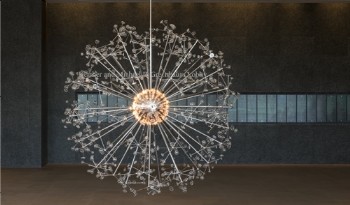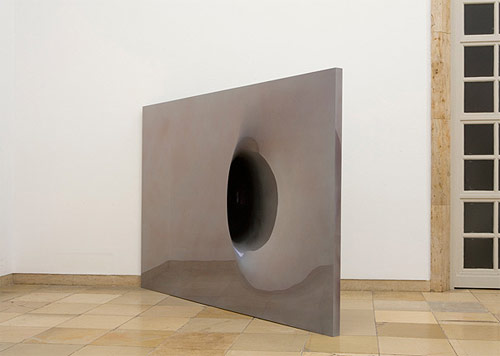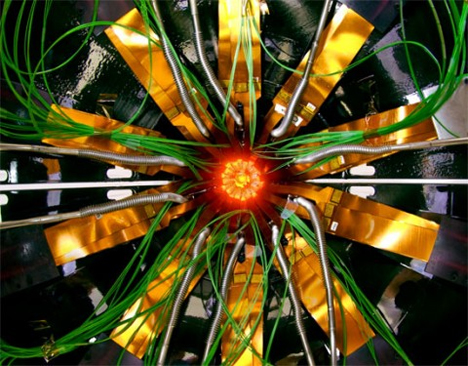Short Fuse Commentary: Josiah McElheny and CERN — Researching the Possibilities
Art and science rebuffed each other in this show. Visitors are unlikely to leave with either a greater understanding of cosmology or of Josiah McElheny’s art.
Josiah McElheny: Some Pictures of the Infinite. At the Institute of Contemporary Art, Boston, MA, through October 14.
By Harvey Blume.

Scattering Surface, the second piece in Josiah McElheny’s Big Bang Series, which describes the creation of the universe.
Conceptual art is sometimes thought of as a dodge, a shortcut, a way of skipping the detail-oriented work of representing reality. There are times, though, when the conceptual approach does more justice to the complex nature of things than representational skill can achieve.
These thoughts occur in connection with the work of Josiah McElheny. Until Some Pictures of the Infinite, his current show at the ICA, McElheny was known in the Boston area through two pieces, one owned by ICA (“Czech Modernism Mirrored and Reflected Infinitely”), the other by the MFA (“Endlessly Repeating Twentieth Century Modernism”). Both bear daunting titles, to be sure, but are not weighed down by them. They are elegant and engaging, using reflective surfaces to create sensations of endless interiority. When getting lost in them, I sometimes think of a comment by artist/architect Anish Kapoor to the effect that the dimension that counts most to today’s artist—the “ultramodern” dimension—is that of inside out.
Kapoor is celebrated for teasing and defying everyday distinctions between interior and exterior. It’s as if he has devised his own non-Euclidean sense of space, one that Escher might have appreciated and that McElheny, among other contemporary artists, approximates in some of his work. Kapoor’s fascination with “inside-out forms” seems, however coincidentally, perfectly suited to a twenty-first-century physics that accommodates event horizons, singularities, and black holes.

Anish Kapoor’s Marsupial — his work is perfectly suited to a twenty-first century physics that accommodates event horizons, singularities, and black holes.
It was in anticipation of the ICA show that I attended a panel discussion at Harvard last winter about McElheny’s aims. He had chosen the most ambitious subject matter, cosmology—the big bang, the expanding universe, and the possibility of a multiverse, or many universes coexisting and overlapping at the quantum level. Inspired by chandeliers at the Metropolitan Opera in New York, McElheny would apply his experience in working with glass and mirrors to creating varied scenarios of the multiverse as it exploded into being.
At the time of the lecture, the Harvard Art Museum was still mounting Prints and the Pursuit of Knowledge in Early Modern Europe, a rich and deservedly much-praised show about the ways in which the arts and the rapidly expanding sciences had interacted during the given period. Curators were eager to include McElheny’s forthcoming exhibit under the same rubric: his glass hangings would afford the kind of visualization for the big bang and the multiverse that printmaking had for the zoology and geography of an earlier age.
Melissa Franklin, a Harvard professor of physics on hand for the discussion, tried gently to curb the curatorial enthusiasm for McElheny’s efforts. Visual art would not reflect or advance astrophysics the way, say, Durer’s prints and drawings had promoted the understanding of human anatomy. In fact, according to Franklin, if you entered the lecture halls of contemporary astrophysicists, you would find that efforts to visualize were conspicuous mostly by their absence.
Franklin’s cautionary note came back to me when I visited Some Pictures of the Infinite. The glass works might have been rewarding in their own right but could not shoulder the theme. Art and science rebuffed each other in this show. Visitors are unlikely to leave with either a greater understanding of cosmology or of McElheny’s art.

CERN — the collider itself is nothing less than a feast for the eyes and through them the imagination.
I recalled what Prof. Franklin had said about how the multiverse is likely to be portrayed in today’s physics classrooms: there would be an object on a blackboard labeled Universe A, an adjacent object chalked in as Universe B, and between them, in big caps, the word “THEORY.” This schema lacks for visual stimuli but conveys, conceptually, a respect for what today is at best hypothetical in science and may remain so indefinitely.
It’s not always the case that new physics need starve art of visual satisfaction. My case in point is the large hadron collider at CERN, where persuasive evidence of the Higgs boson has been found. The Higgs boson, for all that it supplies mass to the universe, may defy visual representation, but the collider itself, as photographs amply attest, is nothing less than a feast for the eyes and through them the imagination. CERN is a fascinating structure that aims at giving clues to the structure and origins of the cosmos. It has been compared to Chartre and other great gothic cathedrals. The comparison is valid only to a point. At Chartre, the answers were known in advance. You entered to absorb them further and to pray to them. CERN gives no answers in advance. It sifts through the possibilities and, in the process, achieves epochal beauty.

I also was disappointed by the this show at the ICA, and for the same reasons, I guess, as was the reviewer. Chandeliers, however elegant, are not even a useful suggestion of the speculative multiverse. I think that the artwork would be better with no “explanation” at all, just standing on its own, than it is with the cosmological freight.
exactly, i couldn’t agree more.
plus it seems his previous work is not on display at the moment either at the ICA or the MFA.